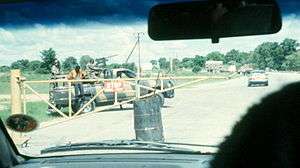Caprivi conflict
| Caprivi Conflict | |||||||
|---|---|---|---|---|---|---|---|
 Military escort through the Caprivi Strip. | |||||||
| |||||||
| Belligerents | |||||||
|
|
| ||||||
| Commanders and leaders | |||||||
|
|
| ||||||
| Strength | |||||||
| N/A | N/A | ||||||
| Casualties and losses | |||||||
| N/A | N/A | ||||||
The Caprivi conflict was an armed conflict between the Namibian government and the Caprivi Liberation Army, a rebel group working for the secession of the Caprivi Strip.[1]
Background
The Caprivi Strip in the north east of Namibia is mainly inhabited by the Lozi people. They share a common language and history, and often feel more connected with Lozi people in neighbouring countries Zambia, Angola, Botswana and South Africa.
The Namibian government has accused the CLA of being allied with the Angolan rebel movement UNITA. UNITA is very unpopular in Namibia since it helped South Africa fighting SWAPO during the liberation struggle,[2] and is considered to be an enemy of the state by many.
One cause of the conflict can be seen in a previous power struggle between Mishake Muyongo and the SWAPO leadership during exile in Angola. In July 1980 Muyongo was ousted from being SWAPO Vice-President under the accusation of being involved in subversive activities and pursuing secessionist ambitions. He was subsequently detained in Zambia and Tanzania, followed by an alleged purge against Caprivians in SWAPO.[3]
After his return to Namibia in 1985 Muyongo formed the United Democratic Party (UDP) which joined the Democratic Turnhalle Alliance (DTA). He was President of DTA from 1991 until 1998 when he was expelled as a result of his support for the secession of his home region.[4]
Course of the conflict

The Caprivi Liberation Army was formed in 1994. The rebel movement's goal is Caprivi self-rule.
In October 1998 the Namibian Defence Force with the support of the Special Field Force discovered and raided a CLA training camp. That resulted in more than 100 armed CLA men and about 2,500 civilians fleeing into Botswana. Amongst the refugees were leaders of the CLA, namely Mishake Muyongo and Mafwe Chief Boniface Mamili. Both were granted asylum in Denmark. Namibia unsuccessfully demanded Botswana and Denmark to hand over the rebels, and President Nujoma called the rebels "traitors and murderers" and stated that they would be punished for their crimes.[5]
On 2 August 1999 CLA launched unanticipated attacks on army base, border post, and the police station of Katima Mulilo, the provincial capital of the Caprivi Region. They also occupied the state-run radio station. In the fighting that followed between rebel and government forces 14 people were killed. A state of emergency was declared in the province, and the government arrested alleged CLA supporters.[6] Mishake Muyongo said that the rebellion was "just the beginning", but the government's hard crack down forced it to come to an abrupt stop.
The conflict sought many human rights abuses. Both Angolan and Namibian forces, and UNITA were accused of committing human rights violations against the population in the Caprivi Strip.[7]
Aftermath
Shortly after the unsuccessful secession attempt about 3,000 people sought refuge in neighbouring Botswana for fear of reprisals from the Namibian government. They were granted refugee status and accommodated at the Dukwe camp. As of December 2015 there are still several hundred Namibians living in the camp, although about 2,100 have returned to Namibia.[8]
In 1999, 132 alleged participants were arrested and charged with high treason, murder and a host of other offences. Judgement in the resulting trial, known as the Caprivi treason trial was heavily delayed, and prisoners were only acquitted in 2012, a situation that Amnesty International repeatedly complained about.[9]
On 7 October 2002, the Itengese nation severed all ties with Namibia and declared the independent, sovereign Free State of Caprivi Strip/Itenge their national homeland.[10] This nation is not recognised by any other government, though, least of all Namibia.
References
- ↑ "Caprivi Liberation Front". fas.org. Retrieved 2008-08-13.
- ↑ Colin Leys & John S. Saul (1994): Liberation without Democracy? The Swapo Crisis of 1976. In: Journal of Southern African Studies 20 (1)
- ↑ Justine Hunter (2008): Die Politik der Erinnerung und des Vergessens in Namibia. Frankfurt /M. (Peter Lang)
- ↑ Graham Hopwood (2008): Guide to Namibian Politics. Windhoek (NID), p. 214-215
- ↑ "Namibia calls on Botswana to hand over rebels". BBC. 1998-11-08. Retrieved 2006-08-26.
- ↑ Lamb, Guy (October 1999). "Civil supremacy of the military in Namibia: A retrospective case study". NamibWeb.
- ↑ "Civilians suffer as Angolan conflict fuels insecurity on the Namibian border". Amnesty International. Archived from the original on 2008-09-12. Retrieved 2008-08-13.
- ↑ "Namibian refugee status revocation postponed". The Namibian. NAMPA. 4 March 2016. p. 5.
- ↑ "Namibia: Justice delayed is justice denied. The Caprivi treason trial". Amnesty International. Archived from the original on 2010-12-06. Retrieved 2009-06-16.
- ↑ "Caprivi Liberation Front/Caprivi Liberation Movement". Global Security. Retrieved 2009-06-19.